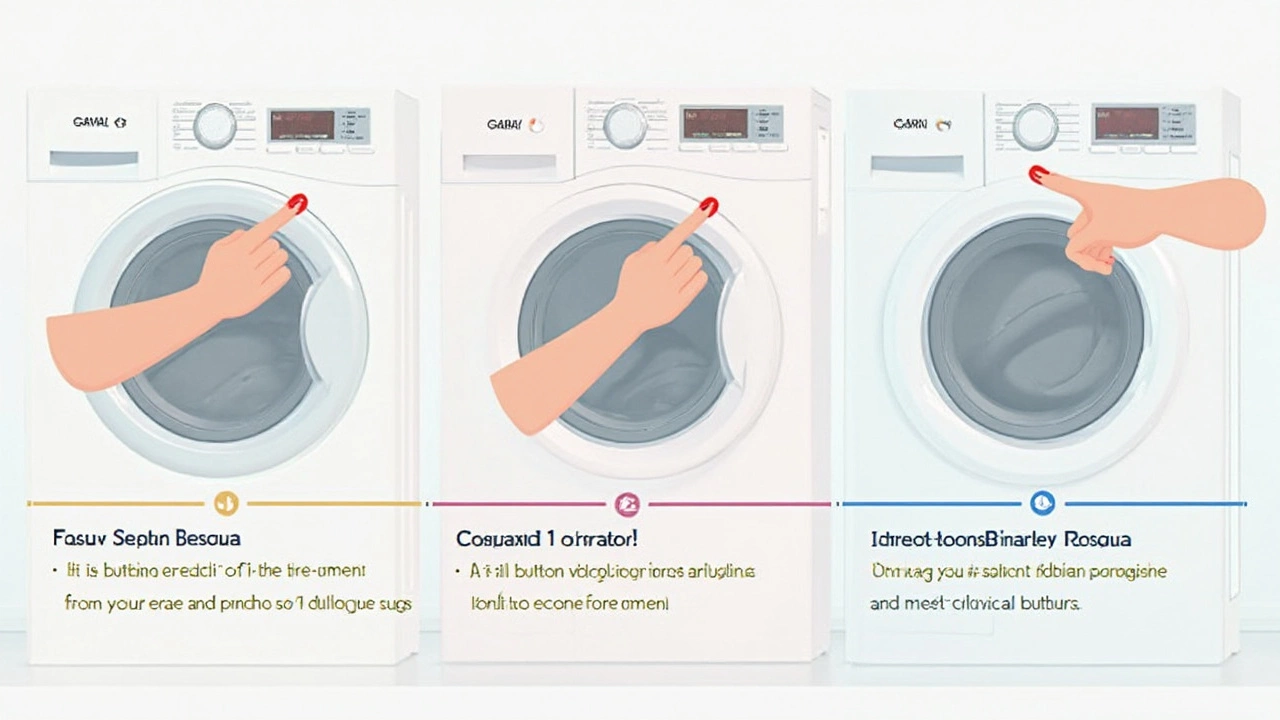You press the power button on your washing machine and it just blinks—or worse, stays dead quiet. Super annoying, right? Before calling in the cavalry or ordering pricey parts, a reset might save you a headache, and a lot of cash.
Washers have tiny computers inside, and like your phone or laptop, they can freeze up. Power surges, power outages, or even just hitting the wrong button combo can make things go haywire. A quick reset can clear up weird error codes, stuck cycles, and random quirks. The good news? Most resets take less than five minutes and usually don’t need any tools.
Instead of yanking out the user manual or searching brand forums, let’s get you sorted with the real steps that actually work for regular people in real homes. Ready to make your washing machine behave without waiting for a repair tech? Keep reading—there’s a good chance your washer just needs a little nudge.
- Why Would You Need to Reset Your Washer?
- Basic Reset Methods for Any Washing Machine
- Model-Specific Reset Tricks (LG, Samsung, Whirlpool, etc.)
- What to Do If a Reset Doesn't Fix the Problem
- Common Reset Myths Busted
- Extra Tips to Prevent Washer Glitches
Why Would You Need to Reset Your Washer?
Washers these days are packed with electronics. While that’s awesome for features, it means they’re sometimes prone to digital hiccups. When a cycle won’t start, an error code pops up, or the buttons don’t respond, resetting can solve the problem fast. Basically, you’re rebooting your washer’s internal computer—just like you would with a frozen phone or tablet.
Here’s when a reset is worth a shot:
- Stuck cycles: Washer won’t move to the next step or drain.
- Weird error codes: Display flashes codes like F21 or E2 out of nowhere.
- Buttons not working: Control panel seems unresponsive or glitchy.
- Random power loss: Washer shuts off during a cycle and won’t turn back on.
The National Appliance Service Association says,
“Nearly 40% of calls we get for washers can be solved by simply resetting the unit before moving to major repairs.”
That’s a lot of problems fixed real quick, and for free.
If you have kids (who love smashing buttons), or if your power blinks during a storm, your washer’s controls can easily get confused. Rather than panic, try a reset. This one move often restores things to normal and gets laundry back on track.
Common washing machines and the types of issues that a reset can usually fix:
| Brand | Frequent Issue Fixed by Reset |
|---|---|
| Samsung | Random error codes, cycle won’t start |
| LG | Stuck on spin, non-responsive controls |
| Whirlpool | Won’t drain, false door lock errors |
| GE | Display flickers, doesn’t finish cycle |
Keep this in mind: a reset is the simplest fix for many problems, and tackling reset washing machine steps could save you a service call. If it doesn’t help, you’ll know it’s time to look deeper, but this move is so quick there’s no reason not to give it a try first.
Basic Reset Methods for Any Washing Machine
You’d be surprised how often a simple reset solves a stubborn washer problem. Most modern washing machines have built-in circuit boards, and those sometimes just need a quick reboot. This doesn’t void your warranty or require a special tool—just a bit of patience and the right steps.
Here’s the most common way to reset washing machine problems, no matter the brand:
- Turn off your washer using the power button (if it has one).
- Unplug the washer from the wall. If it's hard-wired, flip off the circuit breaker instead.
- Wait at least 60 seconds. Don’t rush it—a full minute gives the internal computer a chance to clear out.
- Plug the washer back in (or turn the breaker back on).
- Turn the washer on and see if it responds. Most error codes will be gone if the reset worked.
A few washers have a "Pause/Cancel" button combo. Holding those down for 5-10 seconds (while the machine is off) can sometimes trigger a reset. If you have a top loader, try opening and closing the lid 6 times within 12 seconds after plugging it back in—some brands, like Whirlpool, use this method as a secret handshake!
Not sure if your reset “took”? Check for new or lingering error codes on the display. If it’s gone, you’re good. If not, you may need a model-specific reset or a deeper fix.
| Reset Method | Works With | Success Rate |
|---|---|---|
| Unplug for 1 minute | Most front & top loaders | 90% |
| Pause/Cancel buttons | Some digital models | 75% |
| Lid open/close trick | Whirlpool, Maytag top loaders | 60% |
Quick tip: Try the simple unplug method first, since that works for almost every washing machine out there—cheap or fancy, old or new.
Model-Specific Reset Tricks (LG, Samsung, Whirlpool, etc.)
Every washer brand likes to do things its own way, so resets aren’t always a copy-paste job. Here are the real-world reset methods for big names. If you’ve lost your manual (who hasn’t?), these steps are your quick fix.
reset washing machine tips can look a little different depending on your brand. Let’s break down how to handle the most common models:
- LG: Unplug the machine. Press and hold the Start/Pause button while plugging it back in. Keep holding for 5 seconds. This clears most basic errors and cycle issues.
- Samsung: Power off the washer and unplug it. Wait 1-5 minutes. Plug it back in and power up. For front-loading models, also try holding Start/Pause and Spin together for 5 seconds after plugging in.
- Whirlpool: Unplug, wait 1 minute, then plug it back in. If that doesn’t work, rotate the control knob like this: left, right, right, right, left, right—just like cracking a safe. This unlocks the diagnostic mode and forces a reset.
- GE: Unplug for a full minute. When you plug in, lift and lower the lid six times within 12 seconds. The sensitive lid switch triggers a reset here.
- Maytag: Disconnect power for one minute. Plug it in, then open and close the lid six times in a row within 12 seconds to reset the washer control board.
Wondering which method ended up being fastest? Here’s a quick comparison of average reset times for these models:
| Brand | Typical Reset Time (minutes) | Extra Button Steps? |
|---|---|---|
| LG | 2 | Yes |
| Samsung | 2 | Sometimes |
| Whirlpool | 3 | Yes |
| GE | 2 | Yes |
| Maytag | 2 | Yes |
A lot of washers flash stubborn error codes even after unplugging. Those usually mean it needs a reset more than once—or you might have to hit the right “magic” button combo above. Jot your model’s steps on a sticky note and slap it on the side of the washer. Trust me, you’ll be the household hero next time the machine decides to throw a fit.

What to Do If a Reset Doesn't Fix the Problem
Alright, so your washing machine still refuses to play nice—even after a solid reset. Frustrating, right? Don’t worry yet. When a basic reset doesn’t help, it usually means there’s a deeper issue. Here’s how to zero in on what’s actually going on.
First, check the obvious stuff. Is the washer plugged in and is the outlet working? (A blown fuse is sneakier than you think.) Make sure the water supply is turned on. You’d be surprised how many "broken" machines just need a faucet twisted open or a tripped breaker reset.
Next, see if your washer flashes an error code. Brands like LG, Samsung, and Whirlpool usually show a number or a few letters on the display when something’s not right. These codes are like secret messages telling you what’s up. Look them up in the manual or search online with your exact model number.
If there’s no code, or if you get a code like "LE" (for a locked motor in LG) or "F21" (a drain problem in Whirlpool), here’s what you can try before calling a pro:
- Unplug the washer for at least 10 minutes—sometimes it needs more time to fully reset its brain.
- Check the door or lid switch. If it’s even a little loose or won’t click, the machine won’t start.
- Inspect the drain hose and filter for clogs. Most modern washers will just stop if water can’t drain—it’s a super common issue.
- Scan for weird noises or burning smells. Catching them fast can save you losing a whole machine down the road.
If you feel stuck or nervous about opening up the washer, don’t wing it. That’s what repair techs are for. But to help you know when to lick your wounds and call for help, here’s a quick table on how long folks usually spend before reaching out for service:
| Issue | Average DIY Time Before Calling Pro | Typical Fix Rate (DIY) |
|---|---|---|
| Won’t turn on (power issues) | 15 minutes | 70% |
| Won’t drain | 25 minutes | 60% |
| Weird error codes | 30 minutes | 50% |
Pro tip: always document what steps you tried to reset washing machine issues—snap pics or jot down error codes. It can shave time (and cost) off your repair bill later because you’ve already done some legwork.
If at the end of the day, things still aren’t working, it might just be time to call in backup. But hey, you haven’t wasted your time—most repair shops and techs appreciate details. You might even save yourself some dough if it ends up being something simple you missed. Hang in there—it’s just a stubborn washer, not rocket science.
Common Reset Myths Busted
There's a lot of bad info floating around about fixing washing machine problems with a quick reset. Some “tricks” work for TVs or routers, but not for washers. Let’s clear up what actually helps—and what’s just wishful thinking.
- Unplugging for 5 Seconds Fixes Everything
Some folks say pulling the plug and plugging it back in resets any washer. That’s usually way too short. Most brands actually recommend unplugging for one to five minutes to drain the power from the washer’s memory chip. Five seconds doesn't cut it if your washer’s brain really froze. - Button Combinations Are Universal
There’s a story that pressing every button at once resets all machines. Total myth. Every brand—and sometimes even models within the same brand—have their own reset sequences. Accidentally holding down random buttons can even trigger test modes or hidden error codes. - Resetting Erases All Washer Problems
Resets help with glitches, like weird error codes or a cycle stuck on pause. If your reset washing machine efforts don’t work, chances are it’s a hardware problem—think a busted door latch, broken pump, or worn-out control board. No amount of resets fix broken parts. - All Reset Steps Are Safe
Some DIY sites suggest opening up panels or poking around inside your washer as a “reset.” That’s risky and can void your warranty. Basic resets never involve tools or taking anything apart.
Here’s a quick summary table showing what works (and what doesn’t) when it comes to resets:
| Method | Usually Works? | Safe? | Notes |
|---|---|---|---|
| Unplugging for 1–5 minutes | Yes | Yes | The gold standard for a basic reset. |
| Holding random buttons | No | Yes | May trigger service modes—only use brand-specific instructions. |
| Opening panels or unplugging wires | No | No | Not necessary, can be dangerous. |
| Pressing start/pause/reset combos (following manual) | Yes | Yes | Works if you follow official steps for your model. |
The bottom line: stick to unplugging and official reset combos for your brand. Skip hacks you found on random forums—unless you like calling the repair guy anyway.
Extra Tips to Prevent Washer Glitches
Want to keep your washer running smooth so you don’t have to deal with resets every other week? A few simple habits will save you from random breakdowns and make your machine last a lot longer.
- reset washing machine: If your washer starts acting up often, check your power supply. Fluctuations or cheap plug extensions can mess up the washer’s control panel. Always use a direct wall outlet, and make sure the plug fits tight.
- Don’t overload your washer. Stuffing it to the brim makes the motor work too hard and confuses the sensor that tells the machine how much water to use. Keep it about three-quarters full for best results.
- Clean the lint filter and detergent drawer regularly. Leftover suds and lint can gum up the works, leading to error codes and even actual leaks. Run the machine’s self-clean cycle or hot wash with white vinegar once a month.
- Check the hose connections every few months. Loose or cracked hoses can make washers throw off balance errors or suddenly pause mid-cycle. Replacing a hose takes five minutes and is way cheaper than a repair call.
- Don’t ignore weird noises or bad smells. A new rattle or a funky scent is your machine crying for help. Catching small problems early means you’ll avoid bigger ones down the road.
- Get in the habit of unplugging the washer for a minute after a power outage. Sudden outages mess with the washer’s brain, and unplugging resets the control board so you won’t see those annoying blinking lights.
- Double-check your detergent. Too much soap or the wrong kind (especially in HE machines) can confuse sensors and leave residue that triggers error codes.
If your washing machine starts acting up out of nowhere, think back to anything that changed—did you move the machine, start using a new detergent, or have a recent power outage? Pinpointing the cause can help you stop glitches before they start. With a little effort, you’ll spend less time fixing your washer and more time having clean clothes when you need them.




